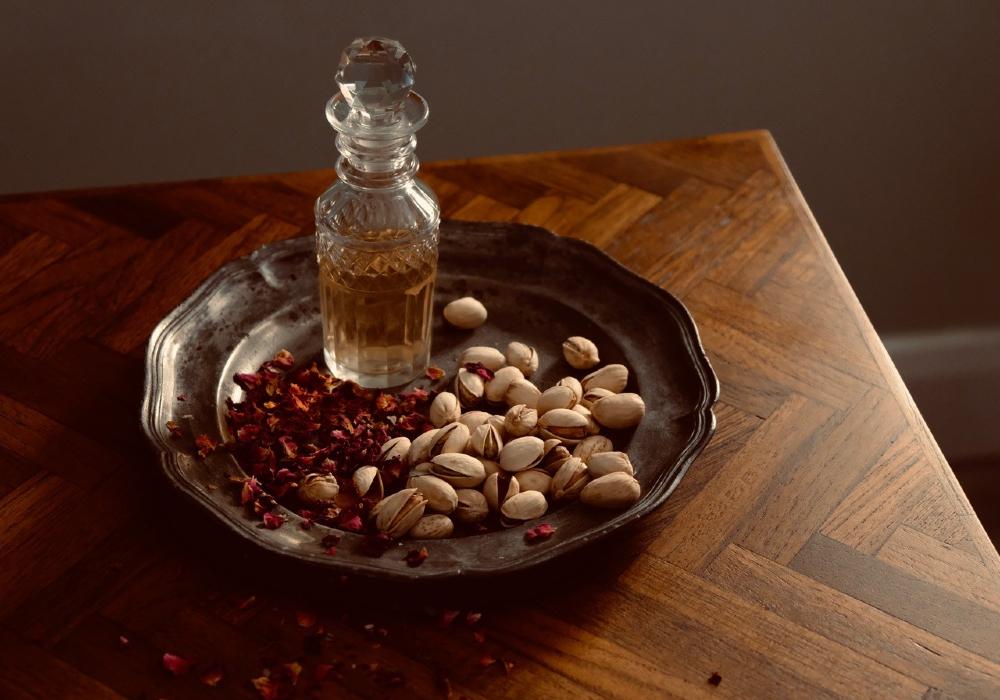Confectionery is present in one form or another in almost every country in the world. As a result, sweets can be an unassuming window into cultures and eating habits across the globe and throughout time. Our sweets can tell us more about society than we might imagine. Throughout the Achaemenid Persian empire, feasting was an expression of identity, a political action and cultural performance. In royal palaces and among the elite, food was a display of decadence for the eyes and the stomach. Sweets were part of this ritual and were not frivolous things, but a manifestation of power.
A time before sugar

Sugar arrived in the in the Middle East sometime after the first century AD, centuries before it arrived in Europe. But before sugarcane was used, honey was the primary source of sweetness, alongside fruits like dates, apricots and pomegranates. Flavours such as rosewater, orange-flower blossom, saffron, star anise and cardamom were prevalent, as well as ingredients like pistachios, almonds and sesame.
The result was an aromatic and fragrant food landscape that many cultures would have admired – confections were edible status symbols that might be gilded in gold or presented in plaited baskets of ivory. The culture of sweetness was one of luxury and innovation: ancient Persia is even credited as inventing the first ice cream-like foods, which originated as far back as 550 BC.
A taste for decadence

But can a sweet also undermine an Empire? The taste of Persian sweetmeats was something that the ancient Greeks got a liking for during the Greco-Persian Wars. And yet, for the ancient Greeks, the excesses of Persian banquets were as divisive as they were delicious. Food highlighted the differences between the two cultures and what some saw as aspirational affluence, others saw as trivial luxuries linked to weakness. Alexander the Great is even rumoured to have said that ‘those who have been used to such revels, never knew how to face danger in the field.’
Food can be a great unifier, but it was on both the banquet table and the battlefield that we saw conflict between these two empires. The upcoming exhibition Luxury and power: Persia to Greece investigates this tension in more depth, exploring how feasting and drinking plays a crucial role as an expression of power at both the Persian court and at the Greek symposium.
Recipe: gilded walnut baklava
Baklava is one of the most renowned of Middle Eastern sweetmeats. Traditionally served with black tea, the exact origins of the dish are hazy. While tea didn’t arrive in the Middle East until at least the ninth century AD, it’s generally acknowledged that the first form of baklava came from the Assyrian empire, around 800 BC. Though the recipe below is a modern version, I have taken inspiration from an account of a banquet hosted by Alexander the Great, 336–324 BC, which talks of gilded sweetmeats, covered in so much gold that ‘when they wanted to eat any of them, they took off the gold and threw that away […] in order that their friends might be spectators of their sumptuousness, and their servants might become masters of the gold.’ Decadent and delicious in equal measure.
Ingredients
450g ready-made filo pastry
225g unsalted butter (plus extra for greasing)
225g walnuts
1 tsp ground cinnamon
Edible gold leaf
For the syrup:
300g golden caster sugar
50g honey
1 tbsp lemon juice
2 tsp rosewater
Method
First heat the oven to 180C/fan160C/gas mark 4 and grease a 30cm x 20cm cake tin with butter.
Then prepare the syrup – to a saucepan add the golden caster sugar, honey, lemon juice and 350ml water. Bring to a simmer over a low heat, stirring gradually until the syrup is clear and small bubbles appear. At this point add the rosewater and put aside to cool.
Chop the walnuts into small pieces using a food processor or knife, taking care not to blitz them to a paste. The mixture should form into a ball if squeezed but still have visible bits of nuts present. Mix in the cinnamon and put aside.
Melt the butter in a pan over a low heat and cut the filo pastry sheets to size, so that they are around the same size as your tin. Once your pack of filo pastry is cut to size, cover with baking parchment and then a damp tea towel to stop the sheets drying out.
Once your butter and pastry sheets are ready, put one sheet in the tin and brush with the melted butter. Lay another sheet on top and brush with butter again. Keep layering like this until half of your filo is used up. (Traditionally there are 40 layers in a baklava, 20 below the nut mix and 20 above.)
When you are halfway through buttering your pastry sheets it’s then time to spread the walnut and cinnamon mixture over the pastry. Press it down lightly with the back of a spoon, making sure to spread it evenly but not to compact the pastry too much.
Continue the layering and buttering process. When you reach the last sheet pour any remaining butter over the top to finish. Then use a sharp knife to cut deep lines into the pastry to create either rectangles or diamond shapes, then bake in the oven for 25 mins.
Reduce the heat to 150C/fan130C/gas mark 2 and bake for a further 45 mins or until golden.
When the baklava comes out of the oven, pour the syrup over the top, allowing it to run into the lines you have cut. Leave it to soak in and add your edible gold just before serving.










